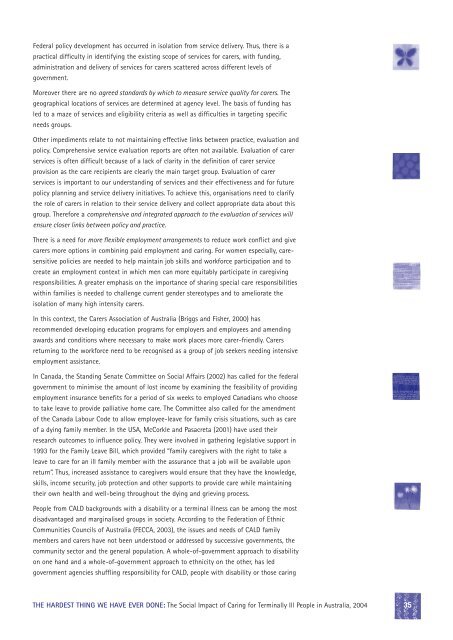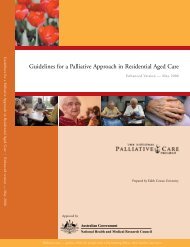The hardest thing we have ever done - Palliative Care Australia
The hardest thing we have ever done - Palliative Care Australia
The hardest thing we have ever done - Palliative Care Australia
Create successful ePaper yourself
Turn your PDF publications into a flip-book with our unique Google optimized e-Paper software.
Federal policy development has occurred in isolation from service delivery. Thus, there is a<br />
practical difficulty in identifying the existing scope of services for carers, with funding,<br />
administration and delivery of services for carers scattered across different levels of<br />
government.<br />
Moreover there are no agreed standards by which to measure service quality for carers. <strong>The</strong><br />
geographical locations of services are determined at agency level. <strong>The</strong> basis of funding has<br />
led to a maze of services and eligibility criteria as <strong>we</strong>ll as difficulties in targeting specific<br />
needs groups.<br />
Other impediments relate to not maintaining effective links bet<strong>we</strong>en practice, evaluation and<br />
policy. Comprehensive service evaluation reports are often not available. Evaluation of carer<br />
services is often difficult because of a lack of clarity in the definition of carer service<br />
provision as the care recipients are clearly the main target group. Evaluation of carer<br />
services is important to our understanding of services and their effectiveness and for future<br />
policy planning and service delivery initiatives. To achieve this, organisations need to clarify<br />
the role of carers in relation to their service delivery and collect appropriate data about this<br />
group. <strong>The</strong>refore a comprehensive and integrated approach to the evaluation of services will<br />
ensure closer links bet<strong>we</strong>en policy and practice.<br />
<strong>The</strong>re is a need for more flexible employment arrangements to reduce work conflict and give<br />
carers more options in combining paid employment and caring. For women especially, caresensitive<br />
policies are needed to help maintain job skills and workforce participation and to<br />
create an employment context in which men can more equitably participate in caregiving<br />
responsibilities. A greater emphasis on the importance of sharing special care responsibilities<br />
within families is needed to challenge current gender stereotypes and to ameliorate the<br />
isolation of many high intensity carers.<br />
In this context, the <strong>Care</strong>rs Association of <strong>Australia</strong> (Briggs and Fisher, 2000) has<br />
recommended developing education programs for employers and employees and amending<br />
awards and conditions where necessary to make work places more carer-friendly. <strong>Care</strong>rs<br />
returning to the workforce need to be recognised as a group of job seekers needing intensive<br />
employment assistance.<br />
In Canada, the Standing Senate Committee on Social Affairs (2002) has called for the federal<br />
government to minimise the amount of lost income by examining the feasibility of providing<br />
employment insurance benefits for a period of six <strong>we</strong>eks to employed Canadians who choose<br />
to take leave to provide palliative home care. <strong>The</strong> Committee also called for the amendment<br />
of the Canada Labour Code to allow employee-leave for family crisis situations, such as care<br />
of a dying family member. In the USA, McCorkle and Pasacreta (2001) <strong>have</strong> used their<br />
research outcomes to influence policy. <strong>The</strong>y <strong>we</strong>re involved in gathering legislative support in<br />
1993 for the Family Leave Bill, which provided “family caregivers with the right to take a<br />
leave to care for an ill family member with the assurance that a job will be available upon<br />
return”. Thus, increased assistance to caregivers would ensure that they <strong>have</strong> the knowledge,<br />
skills, income security, job protection and other supports to provide care while maintaining<br />
their own health and <strong>we</strong>ll-being throughout the dying and grieving process.<br />
People from CALD backgrounds with a disability or a terminal illness can be among the most<br />
disadvantaged and marginalised groups in society. According to the Federation of Ethnic<br />
Communities Councils of <strong>Australia</strong> (FECCA, 2003), the issues and needs of CALD family<br />
members and carers <strong>have</strong> not been understood or addressed by successive governments, the<br />
community sector and the general population. A whole-of-government approach to disability<br />
on one hand and a whole-of-government approach to ethnicity on the other, has led<br />
government agencies shuffling responsibility for CALD, people with disability or those caring<br />
THE HARDEST THING WE HAVE EVER DONE: <strong>The</strong> Social Impact of Caring for Terminally Ill People in <strong>Australia</strong>, 2004<br />
35
















